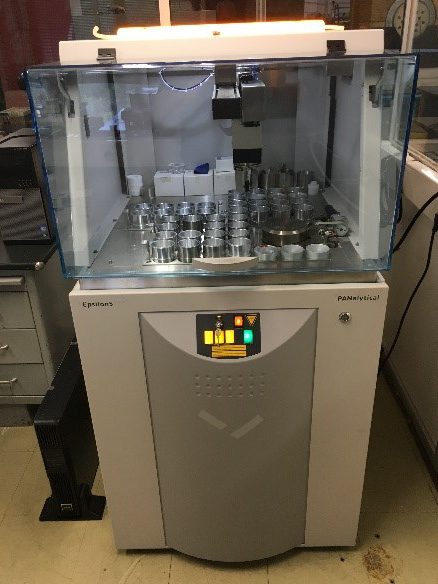The commercial benchtop XRF spectrometer (Model Epsilon 5 by PANalytical) that utilizes, high energy exciting beam and polarization geometry to measure trace elements in environmental, biological and biomedical samples. It belongs to the Environmental Radioactivity Laboratory of the Institute of Nuclear and Radiological Science & Technology, Energy & Safety, and purchased through the ENTEC, FP7-REGPOT project 2013-2016, but it operates at the XRF premises of INPP being also accessible for in-house research and services. Epsilon 5 is constructed with optimized Cartesian‐triaxial geometry composing of several secondary targets for attaining lower spectral background and with extended K line excitation provided by the capability to operate the X‐ray tube at the maximum high voltage of 100 kV. The secondary target‐XRF spectrometer includes a side‐window low power X‐ray tube with a W/Sc anode (spot size 1.8–2.1 cm, 100 kV max voltage, 6 mA current, 600 W maximum power consumption). The characteristic X‐rays emitted from the sample are detected by a Ge X‐ray detector with 140 eV FWHM at MnKα, 30 mm2 and 5 mm thick Ge crystal with 8 μm Be window. The spectrometer is equipped with eight secondary targets (Al, CaF2, Fe, Ge, Zr, Mo, Al2O3, and LaB6) that can polarize the X‐ray tube generated incident radiation through the Barkla X-ray scattering. The high energy operating condition of the X‐ray tube (100 kV) in conjunction with the Ge based energy dispersive detection system is quite advantageous for the analysis of medium‐high atomic number elements (Z > 40) through their respective K-lines, as usually their L‐lines lie in “crowded” parts of the XRF spectrum, commonly overlapped by the K lines of more abundant elements.

The high energy, high polarization benchtop energy dispersive XRF spectrometer for ultra-trace element analysis of environmental samples
